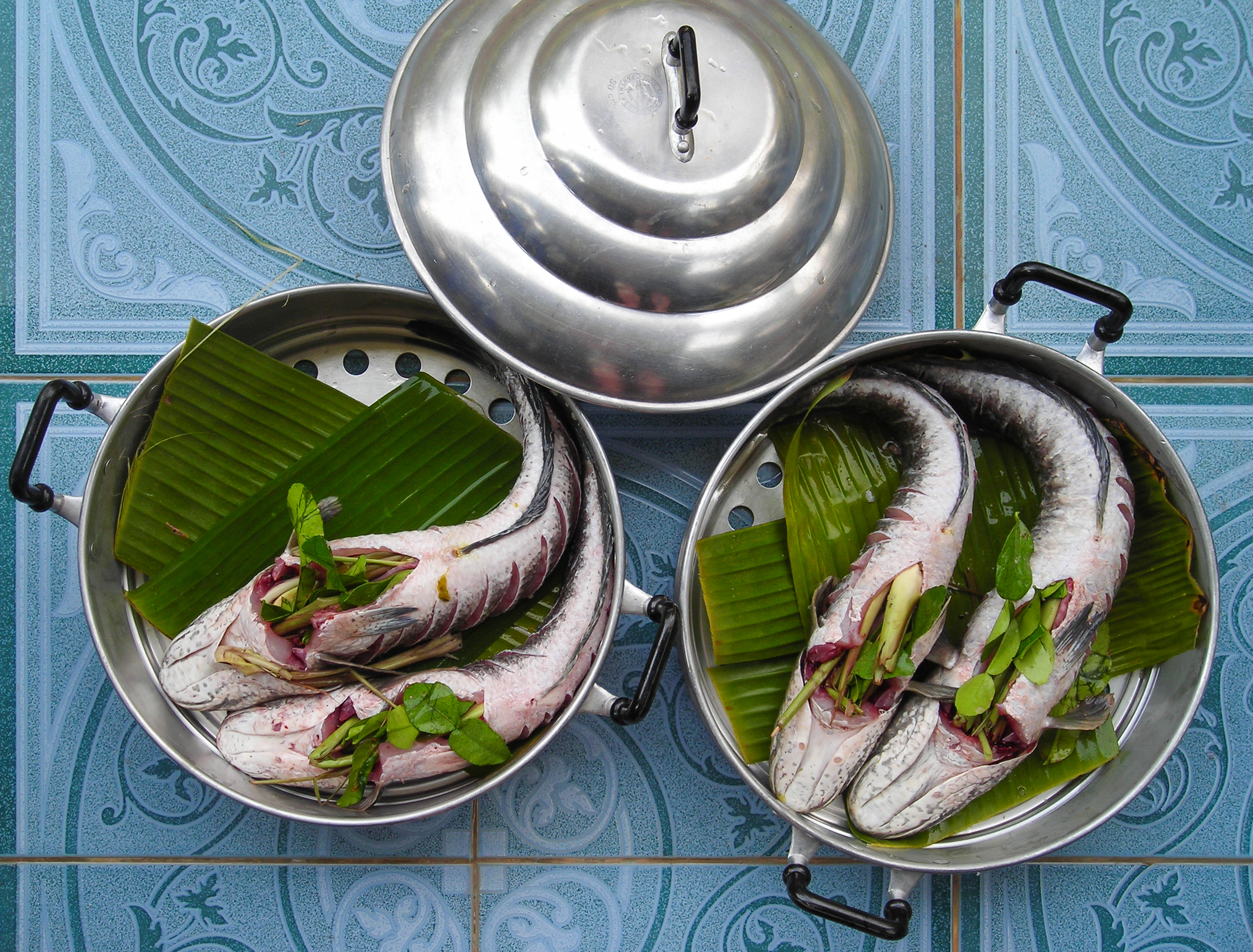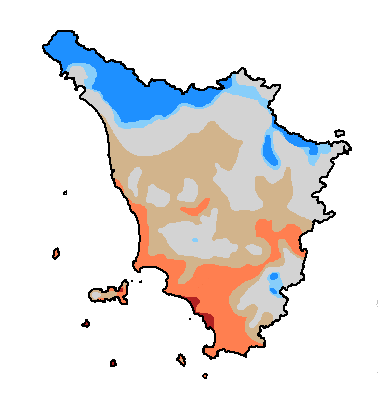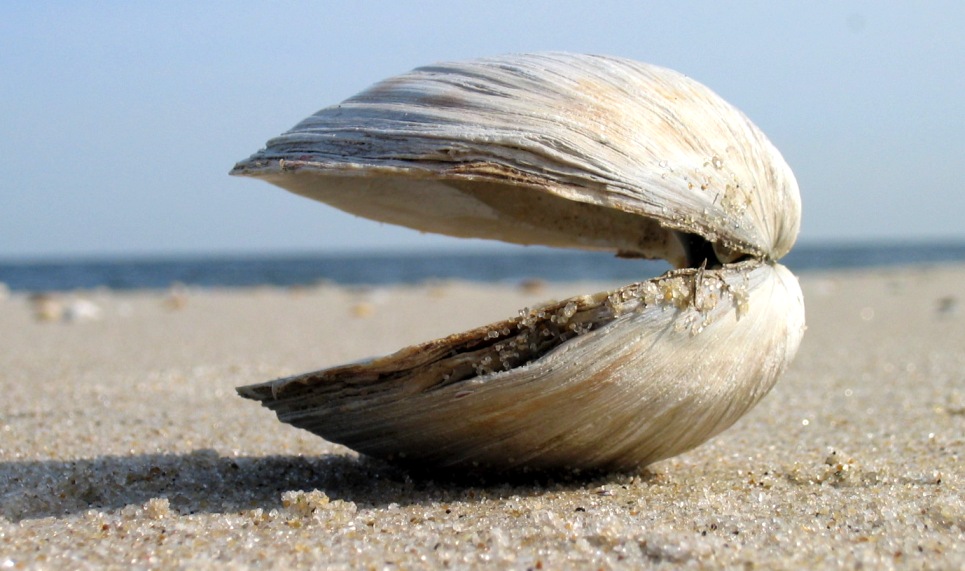|
Cioppino
Cioppino (, ; from ) is a fish stew originating in San Francisco, California, an Italian-American cuisine related to various fish soups in Italian cuisine. Description Cioppino is traditionally made from the catch of the day, which in San Francisco is typically a combination of dungeness crab, clams, shrimp, scallops, squid, mussels, and fish, all sourced from the Pacific. The seafood is then combined with fresh tomatoes in a wine sauce. The dish can be served with toasted bread, either local sourdough or French bread. The bread acts as a starch, similar to a pasta, and is dipped into the sauce. History Cioppino was developed in the late 1800s by Italian immigrants and Spaniards and some Portuguese who fished off Meiggs Wharf and lived in the North Beach neighborhood of San Francisco, many from the port city of Genoa. When a fisherman came back empty-handed, he would walk around with a pot for the other fishermen to chip in whatever they could. This became his "cioppino". ... [...More Info...] [...Related Items...] OR: [Wikipedia] [Google] [Baidu] [Amazon] |
Fish Stew
Fish stew is a stew with a soup base or ingredient of fish as food. List Types of fish stew from around the world include: * '' Asam Pedas'' ( Indonesian) and ( Malaysian) * ''Bouillabaisse'' ( Provençal fish stew originating from Marseille, France) * ''Bourride'' (another fish stew from Provence) * '' Brudet'' ( Italian, from Adriatic Sea) * ''Buridda'' (Italian, from Liguria) * '' Cacciucco'' (Italian, from Livorno) * '' Caldeirada'' ( Portuguese) * '' Caldo de mariscos'' ( Mexican) stew, also known as ''caldo de siete mares'' * ''Chepa pulus'' (tamarind-based South Indian fish stew from Andhra Pradesh) * Cioppino (San Francisco version of an Italian fish stew) * '' Cotriade'' (from Brittany) * Fish head curry * ''Ghalieh mahi'' ( Persian) * '' Haemul jeongol'' ( Korean) * '' Halászlé'' ( Hungarian paprika-based river fish soup) * '' Kokotxas'' (a traditional Basque fish stew) * '' Maeuntang'' (spicy Korean soup) * ''Meen Kuḻambu'' (traditional Tamil Kuzhambu stew, mad ... [...More Info...] [...Related Items...] OR: [Wikipedia] [Google] [Baidu] [Amazon] |
Italian-American Cuisine
Italian-American cuisine () is a style of Italian cuisine adapted throughout the United States. Italian-American food has been shaped throughout history by various waves of immigrants and their descendants, called Italian Americans. As immigrants from the different regions of Italy settled throughout the various regions of the United States, many brought with them a distinct regional Italian culinary tradition. Many of these foods and recipes developed into new favorites for the townspeople and later for Americans nationwide. Influences Italian-American food is based primarily on the culinary traditions of southern Italian immigrants, although a significant number of northern Italian immigrants also came to the United States and also influenced this style of cuisine to some extent. Italian-Americans often identify foods with their regional heritage. Southern Italian staples include dry pasta, tomato sauce, and olive oil, whereas northern Italian staples include foods such a ... [...More Info...] [...Related Items...] OR: [Wikipedia] [Google] [Baidu] [Amazon] |
Fish Soup
Fish soup is a food made by combining fish or seafood with vegetables and stock, juice, water, or another liquid. Hot soups are additionally characterized by boiling solid ingredients in liquids in a pot until the flavors are extracted, forming a broth. Traditionally, soups are classified into two main groups: ''clear soups'' and ''thick soups''. The established French classifications of clear soups are ''bouillon'' and ''consommé''. Thick soups are classified depending upon the type of thickening agent used: '' bisques'' are made from puréed shellfish or vegetables thickened with ''cream''; cream soups may be thickened with béchamel sauce; and '' veloutés'' are thickened with eggs, butter, and cream. Other ingredients commonly used to thicken soups and broths include rice, lentils, flour, and grains; many popular soups also include carrots and potatoes. Fish soups are similar to and often indistinct from fish stews, though soup is generally wetter than stew. Fish soups ha ... [...More Info...] [...Related Items...] OR: [Wikipedia] [Google] [Baidu] [Amazon] |
Dungeness Crab
The Dungeness crab (''Metacarcinus magister'') makes up one of the most important seafood industries along the west coast of North America. Its typical range extends from Alaska's Aleutian Islands to Point Conception, near Santa Barbara, California. Dungeness typically grow at their widest point and inhabit eelgrass beds and sandy bottoms. Its common name comes from the Dungeness Spit in the Strait of Juan de Fuca, Washington state, United States, which shelters a shallow bay inhabited by the crabs. Description Dungeness crabs have four pairs of armored legs, two claws, and a wide, hard shell. A Dungeness's legs are shorter compared to other commercial crabs and their claws have a distinctive hook. The claws of the crab are used both as defense and to tear apart large food items. The crab uses its smaller appendages to pass the food particles into its mouth. Once inside the crab's stomach, food is further digested by the " gastric mill", a collection of tooth-like structures. ... [...More Info...] [...Related Items...] OR: [Wikipedia] [Google] [Baidu] [Amazon] |
Cacciucco
''Cacciucco'' () is an Italian fish stew native to the western coastal towns of Tuscany.Danny Meyer, ''The Union Square Cafe Cookbook: 160 Favorite Recipes from New York's Acclaimed Restaurant'' (HarperCollins 2005). It is especially associated with the port city of Livorno, in Tuscany,Patrizia Chen, ''Rosemary and Bitter Oranges: Growing Up in a Tuscan Kitchen'' (Simon & Schuster, 2010).Clifford A. Wright, ''The Best Stews in the World'', p. 235. and the town of Viareggio north of it. Overview ''Cacciucco'' is a hearty stew consisting of several different types of fish and shellfish; one tradition holds that there should be five different types of fish in the soup, one for each letter ''c'' in ''cacciucco''. A wide variety of Mediterranean fish and shellfish may be used, such as red gurnard, armored gurnard, scorpionfish (''scorfano''), small clams such as littleneck or manila, firm-fleshed fish such as monkfish or other whitefish, red snapper, John Dory, or grouper,Pino ... [...More Info...] [...Related Items...] OR: [Wikipedia] [Google] [Baidu] [Amazon] |
Fish As Food
Many species of fish are caught by humans and consumed as food in virtually all regions around the world. Their meat has been an important dietary source of protein and other nutrients in the human diet. The English language does not have a special culinary name for food prepared from fish like with other animals (as with '' pig'' vs. ''pork''), or as in other languages (such as Spanish '' pez'' vs. '' pescado''). In culinary and fishery contexts, ''fish'' may include so-called shellfish such as molluscs, crustaceans, and echinoderms; but, more expansively, ''seafood'' covers both fish and other marine life used as food. Since 1961, the average annual increase in global apparent food fish consumption (3.2 percent) has outpaced population growth (1.6 percent) and exceeded the increase in consumption of meat from all terrestrial animals except poultry (4.9 percent), both combined (2.8 percent) and individually (bovine, ovine, porcine, et cetera). In ''per capita'' terms, f ... [...More Info...] [...Related Items...] OR: [Wikipedia] [Google] [Baidu] [Amazon] |
Genoa
Genoa ( ; ; ) is a city in and the capital of the Italian region of Liguria, and the sixth-largest city in Italy. As of 2025, 563,947 people live within the city's administrative limits. While its metropolitan city has 818,651 inhabitants, more than 1.5 million people live in the wider metropolitan area stretching along the Italian Riviera. On the Gulf of Genoa in the Ligurian Sea, Genoa has historically been one of the most important ports on the Mediterranean: it is the busiest city in Italy and in the Mediterranean Sea and twelfth-busiest in the European Union. Genoa was the capital of one of the most powerful maritime republics for over seven centuries, from the 11th century to 1797. Particularly from the 12th century to the 15th century, the city played a leading role in the history of commerce and trade in Europe, becoming one of the largest naval powers of the continent and considered among the wealthiest cities in the world. It was also nicknamed ''la S ... [...More Info...] [...Related Items...] OR: [Wikipedia] [Google] [Baidu] [Amazon] |
Tuscany
Tuscany ( ; ) is a Regions of Italy, region in central Italy with an area of about and a population of 3,660,834 inhabitants as of 2025. The capital city is Florence. Tuscany is known for its landscapes, history, artistic legacy, and its influence on high culture. It is regarded as the birthplace of the Italian Renaissance and of the foundations of the Italian language. The prestige established by the Tuscan dialect's use in literature by Dante Alighieri, Petrarch, Giovanni Boccaccio, Niccolò Machiavelli and Francesco Guicciardini led to its subsequent elaboration as the language of culture throughout Italy. It has been home to many figures influential in the history of art and science, and contains well-known museums such as the Uffizi and the Palazzo Pitti. Tuscany is also known for its wines, including Chianti, Vino Nobile di Montepulciano, Morellino di Scansano, Brunello di Montalcino and white Vernaccia di San Gimignano. Having a strong linguistic and cultural identity, ... [...More Info...] [...Related Items...] OR: [Wikipedia] [Google] [Baidu] [Amazon] |
Liguria
Liguria (; ; , ) is a Regions of Italy, region of north-western Italy; its Capital city, capital is Genoa. Its territory is crossed by the Alps and the Apennine Mountains, Apennines Mountain chain, mountain range and is roughly coextensive with the former territory of the Republic of Genoa. Liguria is bordered by France (Provence-Alpes-Côte d'Azur) to the west, Piedmont to the north, and Emilia-Romagna and Tuscany to the east. It rests on the Ligurian Sea, and has a population of 1,509,908 as of 2025. The region is part of the Alps–Mediterranean Euroregion. Etymology The name ''Liguria'' predates Latin and is of obscure origin. The Latin adjectives (as in ) and ''Liguscus'' reveal the original root of the name, ''ligusc-'': in the Latin name -sc- was shortened to -s-, and later turned into the -r- of , according to rhotacism (sound change), rhotacism. Compare whence . The name derives from the ancient Ligures people, although the territory of this people was much larger th ... [...More Info...] [...Related Items...] OR: [Wikipedia] [Google] [Baidu] [Amazon] |
Ciuppin
Liguria (; ; , ) is a region of north-western Italy; its capital is Genoa. Its territory is crossed by the Alps and the Apennines mountain range and is roughly coextensive with the former territory of the Republic of Genoa. Liguria is bordered by France (Provence-Alpes-Côte d'Azur) to the west, Piedmont to the north, and Emilia-Romagna and Tuscany to the east. It rests on the Ligurian Sea, and has a population of 1,509,908 as of 2025. The region is part of the Alps–Mediterranean Euroregion. Etymology The name ''Liguria'' predates Latin and is of obscure origin. The Latin adjectives (as in ) and ''Liguscus'' reveal the original root of the name, ''ligusc-'': in the Latin name -sc- was shortened to -s-, and later turned into the -r- of , according to rhotacism. Compare whence . The name derives from the ancient Ligures people, although the territory of this people was much larger than the current administrative region; it included all of North-west Italy south to the Po r ... [...More Info...] [...Related Items...] OR: [Wikipedia] [Google] [Baidu] [Amazon] |
Clam
Clam is a common name for several kinds of bivalve mollusc. The word is often applied only to those that are deemed edible and live as infauna, spending most of their lives halfway buried in the sand of the sea floor or riverbeds. Clams have two shells of equal size connected by two adductor muscles and have a powerful burrowing foot. They live in both freshwater and marine environments; in salt water they prefer to burrow down into the mud and the turbidity of the water required varies with species and location; the greatest diversity of these is in North America. Clams in the culinary sense do not live attached to a substrate (whereas oysters and mussels do) and do not live near the bottom (whereas scallops do). In culinary usage, clams are commonly eaten marine bivalves, as in clam digging and the resulting soup, clam chowder. Many edible clams such as palourde clams are ovoid or triangular; however, razor clams have an elongated parallel-sided shell, suggesting ... [...More Info...] [...Related Items...] OR: [Wikipedia] [Google] [Baidu] [Amazon] |









